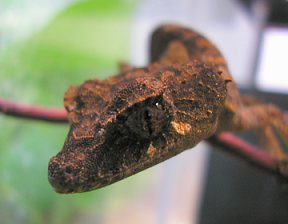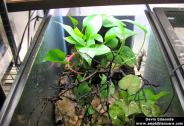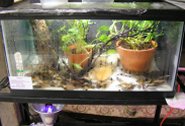
Spearpoint Leaf-tailed Gecko (Uroplatus ebenaui)

Introduction: The spearpoint leaf-tailed gecko belongs to an unusual group of nocturnal geckos native to the island of Madagascar. All geckos belonging to the genus Uroplatus have cryptic coloration and patterns to mimic different parts of their environment. The spearpoint leaf-tailed gecko mimics dried leaves. This species varies in color from dark chocolate brown to light tan. Some geckos are even red, burgundy or orange in color. Most have a reticulated pattern covering their body to some degree. Small fleshy projections or spikes jut out from their body and are particularly noticeable over their eyes and on their head. They are the smallest Uroplatus species, generally maturing to just under 4 inches (10 cm) in total length. Uroplatus ebenaui resemble the closely related satanic leaf-tailed gecko (Uroplatus phantasticus), but lack a long leaf-like tail. Instead, the spearpoint leaf-tailed gecko has a short angular, almost diamond-shaped or spear-shaped, tail. When threatened, some spearpoint leaf-tailed geckos will drop their front arms from the perch they are on and hang from their back legs to very accurately mimic a dried leaf.
Male geckos can easily be distinguished from females by the presence of their hemipenal bulge. Some have also suggested that tail size and shape can be used to sex spearpoint leaf-tailed geckos, but looking for a hemipenal bulge is more reliable. Most people agree that male spearpoint leaf-tailed geckos can be housed together provided the cage is large enough; however I have no personal experience housing multiple males together so I’m not able to agree with or dispute this claim. I strongly encourage those interested in Uroplatus to purchase geckos in male-female pairs or trios for the purpose of breeding, rather than simply for display or pets.
Starting with healthy stock is important. Whenever possible, purchase geckos that were born in captivity because they will generally be in better health than their wild-caught counterparts. Unfortunately, it can be difficult to locate captive-bred geckos because nearly all spearpoint leaf-tailed geckos available in the pet trade are wild-caught. Avoid purchasing a gecko that is active during the day, has sunken eyes, open wounds or sores, is missing a tail, or is being kept in poor conditions. I would suggest that each individual wild-caught gecko be quarantined in its own simple enclosure for one or two months regardless of how healthy it appears when purchased. This will provide the keeper time to monitor each individual’s weight and appetite, as well as prevent diseases from spreading between geckos. Uroplatus have a reputation for arriving from Madagascar with large parasite problems so it may be beneficial to take a fecal sample of each gecko to a veterinarian and then medicate accordingly. Wild-caught Uroplatus also often arrive severely dehydrated, so it’s important to provide plenty of water to new arrivals by misting the cage frequently, or even placing the gecko in a hydration or rain chamber for a few hours.
Cage: Spearpoint leaf-tailed geckos are not very active during the day but at night they will use all of the space that is provided to them. A 15 gallon high aquarium that measures 20 inches long by 10 inches wide by 18 inches high (51 cm by 25 cm by 46 cm) is large enough for one male-female pair of geckos. Smaller cages can be used for housing single animals. It’s important that the sides of the enclosure are made of a material that will help maintain a high humidity level, so screen cages should be avoided unless the ambient humidity in the room they are kept is already high. A tight-fitting cover is also important. Screen covers can be used if plastic wrap or glass is taped over half or more of the cover to help keep the humidity level high. If the cage is made of glass or other see-through material it can be beneficial to cover all but one side of the cage with an aquarium background or black poster board.
The main components of their setup should include a substrate, hiding spots, and perches. Paper towels work well as a substrate, particularly in quarantine and isolation cages because they make it easy to collect fecal samples. They are cheap, easy to clean, and easy to replace. It is important to replace them on a regular basis to prevent unwanted bacteria and mold from growing. Another substrate that can work well is a safe soil such as coconut husk fiber (bed-a-beast, eco earth, forest bed, etc.). Foam rubber also is suitable as a substrate, and can be used both in temporary and permanent setups. Substrates such as gravel, moss, and small pieces of bark should be avoided. It can be beneficial to place a layer of leaf compost or dried leaves over the substrate. Oak and magnolia leafs both tolerate high humidity levels and are good choices. Take care to prevent the substrate from becoming too wet. If the substrate is squeezed in your hand and more than a few drops of water come out then it is too wet.
Hide spots, perches, and other cage décor can consist of live or fake plants, branches, driftwood, dried leaves, and pieces of cork bark. It’s important to provide perches that are thin enough for the geckos to hold on to. There should be at least a few small branches or perches that are about the width of the gecko's limbs. I’ve found that bird perches made of manzanita wood work very well. Some pet stores and terrarium supply companies also sell manzanita branches specifically for reptiles that don’t have the metal screws on the end like the bird perches. Cork bark slabs make great hiding spots when positioned at a vertical angle against the side of the cage. If live plants are used, purchase them from a garden center or terrarium supply company that does not use pesticides or fertilizers that could be harmful to reptiles.Established, healthy spearpoint leaf-tailed geckos can be kept in living terrariums. See the article about tropical terrariums for information about creating one.
Temperature and Humidity: Spearpoint leaf-tailed geckos need to be kept cool. A range in temperature from 68°F to 75°F (20°C to 24°C) during the day with a drop to between 60°F and 70°F (16°C and 21°C) at night generally works well. They will not tolerate warm temperatures and often die when exposed to those above 80°F (27°C) for extended periods of time. The best way to keep the cage cool is to keep it in an air conditioned room or cool basement. Occasionally, it may be necessary to cool the cage by placing an ice pack on top of it. Supplemental heating is rarely required, however if it is needed I would suggest using a low wattage infra-red light bulb as opposed to a heat pad or heat tape.
Maintaining high humidity is as important as maintaining cool temperatures. The humidity level in the forest vegetation and scrub layer in Madagascar is constantly high and this should be duplicated in captivity. The humidity level in the cage can range from 80% to 100%. This can be accomplished by spraying the cage with water once or twice a day and restricting ventilation.
Water: A shallow water dish can be provided but is not necessary as long as the cage is misted with water on a regular basis. Leaf-tailed geckos generally prefer to lap water droplets off of plant leaves, glass, and other smooth surfaces as opposed to drinking from a bowl of standing water.
Food: The majority of a spearpoint leaf-tailed gecko’s diet should consist of crickets. In addition to crickets, they can be offered wax worms and small silk worms in a shallow dish. Small moths and other flying insects can also be offered. Some have suggested that fruit baby food will be accepted by leaf-tailed geckos but I have never observed my geckos showing any interest in baby food. Offer adults between three and six food items per gecko two to three times a week at night. If there are live feeders in the cage the next morning, the geckos are being offered to much food at once. Feeder insects should be coated with high quality vitamin and mineral supplements every two to three feedings. Juvenile geckos should have their food supplemented at every feeding.
Last updated 03.19.08Online Resources
Fauna Imports: Uroplatus
The Herp Venue: Spearpoint and Satanic Leaf-tailed Gecko Care
Nature's Dead Leafs and Pez Dispensers: Genus Uroplatus
Of Another Color: Uroplatus
Uroplatus phantasticus Care Sheet by Robert Gundy


